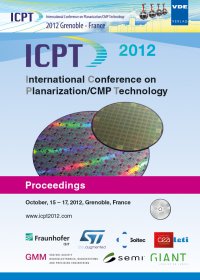Reduction of Edge Exclusion by EPC ring in CMP process
Conference: ICPT 2012 - International Conference on Planarization / CMP Technology
10/15/2012 - 10/17/2012 at Grenoble, France
Proceedings: ICPT 2012
Pages: 6Language: englishTyp: PDF
Personal VDE Members are entitled to a 10% discount on this title
Authors:
Park, Yeongbong; Lee, Youngkyun (Pusan National University, Busan 609-735, South Korea)
Yuh, Minjong; Jeong, Haedo (Pusan National University, Busan 609-735, South Korea )
Abstract:
Edge exclusion is one ofthe most important indicator which determines the yield of chip in a wafer because it means the region that cannot be made to a chip. The edge exclusion is significantly affected by mechanical interaction between retaining ring and polishing pad during CMP process. This is an unavoidable edge effect which shows a non-uniform removal generated by non-uniform stress distribution near the wafer edge. In particular, the polishing pad influences the edge effect dominantly due to its easy-to-deform property as a polymer. So, four types of pad were prepared to evaluate the edge polishing profile versus the type of polishing pad in this study. Also, in order to get more uniform stress near the wafer edge, the CMP head design has become more complicated to control more accurately between the wafer edge and retaining ring. This study is another simple approach to achieve more uniform stress near the wafer edge by developing of edge profile control ring (EPC ring). The EPC ring is equipped in the polishing head with the wafer and protects the wafer from non-uniform stress distribution. From experimental results, authors could achieve a within wafer non-uniformity (WIWNU) of 3% with the edge exclusion of 2mm. Finally, this study shows a possibility to improve the yield of chip production through adoption of simple ring without any special design changes of the CMP equipment. Keywords: Edge Exclusion, Chemical-mechanical Polishing, EPC-ring, FEA, within Wafer Non-uniformity


